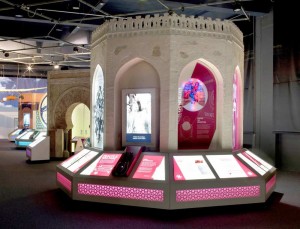“1001 Inventions” honors historic novelties
With the rapid pace of today’s technological advancements, it’s easy to get lost in all the hub-bub. But something that is never recognized in the race to find the “next big thing” is how we got to the awe-inspiring inventions of today. In the “1001 Inventions” exhibitions that have been featured throughout the world, Muslim scientists, engineers and philosophers are finally receiving the credit they deserve.

Healing relics · Many of the exhibitions in “1001 Inventions,” such as “The Hospital Zone,” celebrate various breakthroughs in history. - Photo courtesy of California Science Center Foundation
Traveling from London to Istanbul to New York, “1001 Inventions” has made its way to the California Science Center in Los Angeles. The exhibition delves into myriad advancements made by various Muslim scholars in a fascinating and interactive manner.
Upon entering the exhibition, a short film, 1001 Inventions and the Library of Secrets, gives a succinct introduction to the exhibition and all the enticing innovations that await inside. The film is compelling as it creates an aura of wonder, which in turn establishes an air of intrigue about the groundbreaking discoveries of the Muslim innovators.
An immense “elephant clock,” invented by the exceptional mechanical engineer of the 12th century, Al-Jazari, immediately catches one’s eye. The enormous, intricate display, with knobs and levers and even small figurines, portrays how the clock would appear on the back of an elephant moving through the streets of ancient Arabia.
The work of another great inventor, Abbas Ibn Firnas, is also riveting. The innovator developed a basic structure for a glider, exploring pathways for human flight 1,000 years before the iconic Wright Brothers. The plans and designs for this progressive work are arranged in a manner that captivates viewers not only with the intriguing subject matter, but also with the interesting aesthetics.
Switching gears, and about 100 years after Ibn Firnas, the display of the revolutionary work of Ibn al-Haitham explores the world of optics. Refuting common Greek ideas, his research finally led him to invent the first camera obscura, which he called a “qamara.” The display transports you back in time as it provides a visual illustration of how ancient cameras functioned, allowing the viewer to see how al-Haitham’s “qamara” was set up.
Also featured is the noteworthy Al-Zahwari, one of the greatest physicians of the Middle Ages. His most influential discovery involved using catgut for internal stitching in surgeries. A breakthrough in medical research at the time, catgut is still used for surgeries today. Accordingly, the display honors his greatest accomplishments as it showcases the various surgical tools he designed.
Sinan, a 15th-century architect, also leaves quite the impression with a display of beautifully designed arches. This chief architect of the Ottoman sultans inspired a vast majority of the gorgeous architecture we see today. Whether in the architecture at USC or other brilliantly designed structures around the globe, Sinan’s influence is unmistakable.
“1001 Inventions” proves incredibly audience-friendly with interactive elements that encourage participation. One station allows guests to match various English words to their Arabic roots, while another display has a game where guests can match the constellations mapped by Mariam al-Astrolabi, a 10th-century astronomer.
Writings and paintings that depict Muslim scholars exchanging information go hand in hand with the individual displays. Moreover, a giant map featuring the Muslim trade route, ranging from Spain to China, showcases the various influences on science, technology and art.
This is not your average exhibition — the array of pictures, games, artifacts and even the center’s employees allows for an interactive learning experience, a far superior alternative to reading another dull textbook.
Whether you’re an expert on Muslim civilization or are simply interested in the progression of time, anybody and everybody will find the “1001 Inventions” exhibition a beautiful display of the Golden Age of Invention.
Don’t miss this opportunity to explore the history of Muslim heritage and the enthralling world of innovation and invention.
For more information on “1001 Inventions,” go to 1001inventions.com. The exhibition will be open at the California Science Center until Dec. 31.
